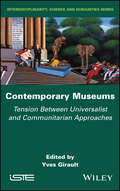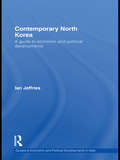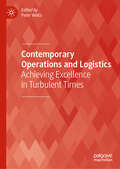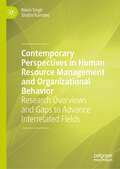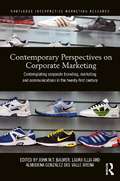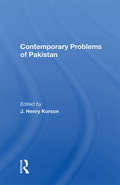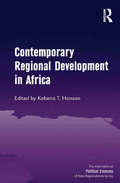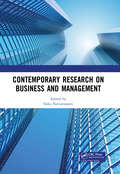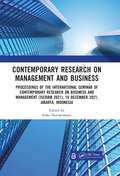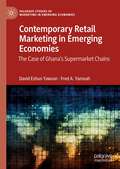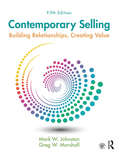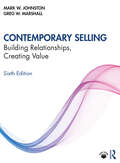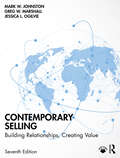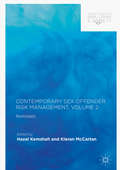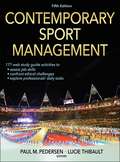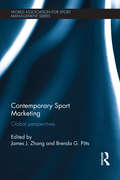- Table View
- List View
Contemporary Movements in Planning Theory: Critical Essays in Planning Theory: Volume 3 (Critical Essays in Planning Theory)
by Patsy HealeyPlanning Theory has a history of common debates about ideas and practices and is rooted in a critical concern for the 'improvement' of human and environmental well-being, particularly as pursued through interventions which seek to shape environmental conditions and place qualities. The third and final volume in this series covers Contemporary Movements in Planning Theory and topics include communicative practices and the negotiation of meaning, networks, institutions and relations, and the complexity 'turn'. The articles selected represent the most influential and controversial recent work in planning theory and are supplemented by detailed introductions by the editors.
Contemporary Museums: Tension between Universalist and Communitarian Approaches
by Yves GiraultAt the center of current debates surrounding the social function of museums, questions concerning museum activities and the participation of both inhabitants and the public arise. In 2019, these questions were the subject of many heated debates at the 34th General Assembly of ICOM in Kyoto, which intended to propose a new definition of the museum. As the representations of the tensions between Universalist and Communitarian approaches are not only largely dependent on the historical and socio-political contexts of the various countries concerned, a generational angle must also be considered. It thus seems totally anachronistic to try to defend a dichotomous vision that is far too simplistic. At the heart of these current events and international issues, this collective work studies, in an international context, the values, actions and discourses advocated for participating in processes such as collection, selection, conservation and interpretation of heritage elements linked to the territories, resources, knowledge and know-how of various communities. The analysis of the tensions and asymmetries of power between various groups of actors – politicians, managers, scientists, visitors, representatives of local or diasporic populations, among others – particularly in the context of decolonization policies of museums, is also a major part of this book.
Contemporary Muslim Travel Cultures: Practices, Complexities and Emerging Issues (Contemporary Geographies of Leisure, Tourism and Mobility)
by C. Michael Hall S. Mostafa Rasoolimanesh Siamak SeyfiThis timely volume brings together various issues in Muslim consumer cultures and provides a comprehensive account of Muslim tourism and tourist behaviour. Islam is a major international religion and Muslims are a majority of the population in many countries in Asia, the Middle East and North Africa. The growth of a substantial middle class, the development of Islamic consumer cultures, rising Muslim market consumption in non-Muslim majority destinations and the growing significance of intra-Muslim traffic and rising outbound tourism expenditure in emerging Muslim markets have all contributed to substantial interest in Muslim tourism. However, travel by Muslims is about far more than the Hajj and Umrah, as important as they are as acts of devotion. Instead, although often portrayed in the West as a monolithic religion, Muslim travel and leisure behaviour is very diverse, with different traditions and cultures leading to a range of expressions of tourism-related consumption culture and practices. Drawing on a range of empirical studies undertaken in different social and economic contexts and countries, this book provides a well-balanced portrayal of the Muslim tourism experience and practices. This book makes a substantial contribution to an improved understanding of Muslim travel culture and will be required reading for anyone interested in this fast-growing market.
Contemporary North Korea: A guide to economic and political developments (Guides to Economic and Political Developments in Asia)
by Ian JeffriesThis book provides full details of contemporary economic and political developments in North Korea since late 2005, continuing the overview of developments which were covered in the author’s North Korea: A Guide to Economic and Political Developments (Routledge 2006). Key topics covered include: the succession; family visits; human rights; nuclear capability and intentions; recent initiatives in international relations, and relations with the United States; and adverse economic and social conditions. Overall, the book demonstrates the degree to which North Korea’s international position is changing. This book provides a comprehensive overview of the current political and economic situation in North Korea today, and is an important resource for all those interested in this country’s recent development.
Contemporary Operations and Logistics: Achieving Excellence in Turbulent Times
by Peter WellsThis edited collection collates the most up-to-date and important research within the area of operations and logistics management. Boasting the combined expertise of one of the largest logistics and operations management academic teams in Europe, it provides both depth and diversity in a balanced portfolio. The first two sections are concerned with key contemporary issues in the subject area, providing a current and up-to-date overview of the field. Section three presents a selection of important cross-cutting themes that impinge upon and inform teaching, research and practice, while the final section includes a celebration of research highlights and showcases cutting-edge applications from leaders in the field. Invaluable to students, researchers and academics alike, this book is compulsory reading for those active within operations and logistics research.
Contemporary Perspectives in Human Resource Management and Organizational Behavior: Research Overviews and Gaps to Advance Interrelated Fields
by Riann Singh Shalini RamdeoThis book aims to address one of the key challenges facing Human Resource Management (HRM) and Organizational Behavior (OB) researchers. It delves into contemporary topics from which focused research models, ideas, and questions can be developed and tested. HRM and OB are closely related and intersect each other in the examination of practices, which are aimed at managing employees and explaining their behaviors. Proposing to provide researchers with easy access to a slew of contemporary research advancements within the field, this work explores ten contemporary research areas within HRM and OB. Topics include innovative HRM/OB responses in crises, alternative work arrangements for the contemporary workplace, employee mental health, from diversity to inclusion in the workplace, workplace harassment, HRM in small and medium enterprises, alternative perspectives in employee turnover, organizational citizenship and counter-productive work behaviors, leading for work engagement, and employee motivation in a changing environment. Providing researchers with a comprehensive overview of research advances within selected contemporary areas, this book seeks to spur critical thinking, spark alternative research perspectives, innovate extensions to existing theories, and provide the foundation from which focused research can grow and develop within these management fields.
Contemporary Perspectives on Corporate Marketing: Contemplating Corporate Branding, Marketing and Communications in the 21st Century (Routledge Interpretive Marketing Research)
by John M. T. Balmer Laura Illia Almudena González del Valle BrenaCorporate marketing and corporate communications are topics that have grown in scholarly and practical importance in these last decades. Fields such as branding, marketing communications and public relations have all contributed to this boost. Whilst there is a large amount of literature on each of these disciplines, there is little systematic development from the perspective of corporate marketing and corporate communication studies, although these two have the most to contribute to how companies manage their brands, image and corporate identities in the 21st Century. This book seeks to redress this balance and provide insights, via case studies or histories, on issues such as nation branding, managing multiple corporate identities during merger and acquisitions and establishing a company’s CSR and green image. Scholars from various disciplines within the fields of public relations, branding, marketing and corporate identity have come together in Contemporary Perspectives on Corporate Marketing to offer the latest approaches and studies in these areas. As such, it will become a platform for developments in the field and serve as a respected reference resource for corporate marketing and corporate communication studies.
Contemporary Perspectives on Ecofeminism (Routledge Explorations in Environmental Studies)
by Nick Rumens Mary PhillipsWhy is ecofeminism still needed to address the environmental emergencies and challenges of our times? Ecofeminism has a chequered history in terms of its popularity and its perceived value in conceptualizing the relationship between gender and nature as well as feeding forms of activism that aim to confront the environmental challenges of the moment. This book provides a much-needed comprehensive overview of the relevance and value of using eco-feminist theories. It gives a broad coverage of traditional and emerging eco-feminist theories and explores, across a range of chapters, their various contributions and uniquely spans various strands of ecofeminist thinking. The origins of influential eco-feminist theories are discussed including key themes and some of its leading figures (contributors include Erika Cudworth, Greta Gaard, Trish Glazebrook and Niamh Moore), and outlines its influence on how scholars might come to a more generative understanding of the natural environment. The book examines eco-feminism's potential contribution for advancing current discussions and research on the relationships between the humans and more than humans that share our world. This timely volume makes a distinctive scholarly contribution and is a valuable resources for students and academics in the fields of environmentalism, political ecology, sustainability and nature resource management.
Contemporary Problems Of Pakistan
by J. Henry KorsonThis book considers the range of social, political, and economic problems of Pakistan. It analyzes the country's attempts to control explosive population growth and cope with a flood of Afghan refugees as well as to deal with the demands for education, women's rights, and greater democracy.
Contemporary Reflections on Business Ethics (Issues in Business Ethics #52)
by Ronald DuskaOver 30 years Ronald F. Duska has established himself as one of the leading scholars in business ethics. This book presents Duska’s articles the years on ethics, business ethics, teaching ethics, agency theory, postmodernism, employee rights, and ethics in accounting and the financial services industry. These reflect his underlying philosophical concerns and their application to real-world challenges — a method that might be called an Aristotelian common-sense approach to ethical decision making.
Contemporary Regional Development in Africa (The International Political Economy of New Regionalisms Series)
by Kobena T. HansonContemporary Regional Development in Africa interrogates well-known concerns in the areas of regionalism and economic integration in contemporary Africa, while offering an added uniqueness by highlighting the capacity imperatives of the issues, and proposing critical policy guideposts. The volume juxtaposes a set of ’dynamic’ entanglements - new and micro-regionalism, informal cross-border trade, intra-African and African FDI plus cross-border investments, infrastructure development, science and technology, regional value-chains, conflict management and regional security - with fluid interpretations of regional development. The chapters provide snapshots of the several emerging and complex regionalisms and highlight a set of relevant and often overlapping analyses - drawing on authors’ nuanced and granular understanding of the African landscape. The varied, yet interlinked, nature of issues covered in this study make the book valuable and attractive to academics, researchers, policymakers and development practitioners.
Contemporary Religious Tourism: Multidisciplinary insights, Environmental Engagement, and Community Impact (Tourism, Hospitality & Event Management)
by Marco ValeriThis book explores the multifaceted impact of religious tourism on prominent global destinations, addressing significant research gaps in this evolving field. Religious tourism, driven by complex psychosocial motives, particularly religious and spiritual needs, has long influenced travel behavior. Pilgrimages, a key aspect of religious tourism, are examined in depth, highlighting their role in fulfilling spiritual and material needs across various belief systems. The book investigates the intricate relationship between religion and tourism, considering factors such as authenticity, emotional solidarity, pro-environmental behaviors, and the educational aspects of spiritual journeys. With case studies from diverse regions such as Greece, India, Italy, and Bulgaria, the book offers a global perspective on how religious tourism intersects with marketing, economics, social development, and sustainability. This volume provides valuable insights for academics, practitioners, and policymakers interested in the profound and diverse implications of religious tourism in different cultural and geographical contexts.
Contemporary Research in Accounting and Finance: Case Studies from the MENA Region
by Abdelghani Echchabi Rihab Grassa Welcome SibandaThe book compiles a comprehensive set of case of studies in business and accounting from the MENA region. These case studies consist of practical research studies with strong theoretical foundations. Hence, the book is a guide to the industries in various sectors regarding the best practices for efficient business and accounting management. In addition, the book will serve as an important teaching reference for business and accounting courses in the MENA region.
Contemporary Research on Business and Management: Proceedings of the International Seminar of Contemporary Research on Business and Management (ISCRBM 2019), 27-29 November, 2019, Jakarta, Indonesia
by Siska NoviaristantiThis book contains selected papers presented at the 3rd International Seminar of Contemporary Research on Business and Management (ISCRBM 2019), which was organized by the Alliance of Indonesian Master of Management Program (APMMI) and held in Jakarta, Indonesia on 27-29th November 2019. It was hosted by the Master of Management Program Indonesia University and co-hosts Airlangga University, Sriwijaya University, Trunojoyo University of Madura, and Telkom University, and supported by Telkom Indonesia and Triputra. The seminar aimed to provide a forum for leading scholars, academics, researchers, and practitioners in business and management area to reflect on current issues, challenges and opportunities, and to share the latest innovative research and best practice. This seminar brought together participants to exchange ideas on the future development of management disciplines: human resources, marketing, operations, finance, strategic management and entrepreneurship.
Contemporary Research on Management and Business: Proceedings of the International Seminar of Contemporary Research on Business and Management (ISCRBM 2021), 18 December 2021, Jakarta, Indonesia
by Siska NoviaristantiThis book contains 74 selected papers presented at the 5th International Seminar of Contemporary Research on Business and Management (ISCRBM 2021), which was organized by the Alliance of Indonesian Master of Management Program (APMMI) and held in Jakarta, Indonesia on 18 December 2021. This online conference was hosted by the Master of Management Program of Indonesia University. This year, ISCRBM focused on research related to driving sustainable business through innovation. Business has had to deal with the Covid-19 pandemic, so a new approach towards managing business to survive competition is indispensable. Innovation is the key for all organizations in surviving in the new normal and beyond. The Seminar aimed to provide a forum for leading scholars, academics, researchers, and practitioners in the business and management area to reflect on the issues, challenges and opportunities, and to share the latest innovative research and best practices. This seminar brought together participants to exchange ideas on the future development of management disciplines: human resource, marketing, operation, finance, strategic management and entrepreneurship.
Contemporary Retail Marketing in Emerging Economies: The Case of Ghana’s Supermarket Chains (Palgrave Studies of Marketing in Emerging Economies)
by David Eshun Yawson Fred A. YamoahThis book highlights the development of retail marketing in developing economies and presents this sector as a major area of growth and business opportunity. With a special focus on supermarket chains, the authors show that the advancement of technology and infrastructure means that there are now increased electronic capabilities for data collection, giving retailers more opportunities to pursue micro and macro-marketing strategies. The authors explain the evolution of this new era of marketing and the associated impact on all stakeholders, especially consumers. Taking the example of Ghana, which is considered a leader among African nations in the use of loyalty cards, the authors are able to set a benchmark for other emerging countries, especially those that are experiencing similar trends. The book is a valuable resource for students, researchers and foreign companies wishing to expand their knowledge of the marketing strategies employed by emerging economies in Sub-Saharan Africa.
Contemporary Sales Force Management
by Tony Carter William WinstonBy analyzing and monitoring current trends in the marketplace, Contemporary Sales Force Management helps sales managers align resources and strategic efforts to gain an edge over competitors. You will develop an understanding of where current and prospective sales opportunities exist in order to fully utilize automation, how to update crisis management policies to reflect changing industry dynamics, and how to raise your level of sales efficiency through the use of customer advisory groups and sales technological tools, such as video conferencing, database management, and up-to-date industry software. Through the book’s important discussions on lowering mutual costs, building long-term customer relationships, improving sales skills, and developing core process skills, you will also learn to think and act with a strategic perspective that successfully steers the sales process.Grounded in practical applications, Contemporary Sales Force Management unites theoretical principles with applied examples and case studies gathered from research with major firms in dynamic markets such as Beijing and Shanghai in China, the European Union, and the United States. From these case studies demonstrating how top players achieve success, you gain critical information on: the role of the sales force manager in organizations strategic issues for an international sales effort gaining functional expertise in sales and marketing along with industry knowledge globalization and its impact on sales management strategies for applying Total Quality Management to sales electronic commerce and cultivating customers on the Web the consequences of having a poorly motivated sales force with low morale developing an environment that fosters and rewards the management of crisis understanding your biases and stereotypical assumptions about others and how these affect decisionmaking dealing with the legal and regulatory environment and ethical issues that arise in the course of managing the sales forceContemporary Sales Force Management is the book managers, entrepreneurs, business people, and faculty and students of executive business education programs have long awaited. Its sample sales plan, specific strategies, and hands-on advice will prove indispensable as you maneuver away from the coattails of your competitors into a leading position in the marketplace.
Contemporary Sculpture and the Critique of Display Cultures: Tainted Goods (Routledge Focus on Art History and Visual Studies)
by Dan AdlerIn this book, Dan Adler addresses recent tendencies in contemporary art toward assemblage sculpture and how these works incorporate tainted materials – often things left on the side of the road, according to the logic and progress of the capitalist machine – and combine them in ways that allow each element to retain a degree of empirical specificity. Adler develops a range of aesthetic models through which these practices can be understood to function critically. Each chapter focuses on a single exhibition: Isa Genzken’s "OIL" (German Pavilion, Venice Biennale, 2007), Geoffrey Farmer’s midcareer survey (Musée d’art contemporain, Montréal, 2008), Rachel Harrison’s "Consider the Lobster" (CCS Bard Hessel Museum of Art, 2009), and Liz Magor’s "The Mouth and Other Storage Facilities" (Henry Art Gallery, Seattle, 2008).
Contemporary Selling: Building Relationships, Creating Value
by Greg W. Marshall Mark W. JohnstonContemporary Selling is the only book on the market that combines full coverage of 21st century personal selling processes with a basic look at sales management practices in a way that students want to learn and instructors want to teach. The overarching theme of the book is enabling salespeople to build relationships successfully and to create value with customers. Johnston and Marshall have created a comprehensive, holistic source of information about the selling function in modern organizations that links the process of selling (what salespeople do) with the process of managing salespeople (what sales managers do). A strong focus on the modern tools of selling, such as customer relationship management (CRM), social media and technology-enabled selling, and sales analytics, means the book continues to set the standard for the most up-to-date and student-friendly selling book on the market today. Pedagogical features include:? Mini-cases to help students understand and apply the principles they have learned in the classroom Ethical Dilemma and Global Connection boxes that simulate real-world challenges faced by salespeople and their managers Role Plays that enable students to learn by doing A companion website, featuring an instructor’s manual, PowerPoints, and other tools to provide additional support for students and instructors, will be coming soon. Please contact Routledge's sales team for advance access to the materials.
Contemporary Selling: Building Relationships, Creating Value
by Greg W. Marshall Mark W. JohnstonContemporary Selling is the only book that combines full coverage of up-to-date personal selling processes with a straightforward look at sales management practices, delivered in a way that students want to learn and instructors want to teach. The overarching theme of the book is enabling salespeople to build relationships successfully and to create value with customers. Johnston and Marshall have created a comprehensive, holistic source of information about the selling function in modern organizations that links the process of selling (what salespeople do) with the process of managing salespeople (what sales managers do). A strong focus on the modern tools of selling, such as customer relationship management (CRM), social media and technology-enabled selling, and sales analytics, means the book continues to set the standard for the most up-to-date and student-friendly selling book on the market today. Pedagogical features include: updated mini cases to engage students and reinforce learning objectives; Ethical Dilemma and Global Connection boxes that simulate real-world challenges faced by salespeople and their managers; Role Play exercises that enable students to learn by doing; and updated discussion queries to drive classroom discussion and help students connect important concepts. This fully updated new edition is an invaluable resource for students of personal selling at both undergraduate and postgraduate levels. Supplementary resources include an instructor’s manual, PowerPoint slides, and other tools to provide additional support for students and instructors.
Contemporary Selling: Building Relationships, Creating Value
by Greg W. Marshall Mark W. Johnston Jessica L. OgilvieContemporary Selling is the only book that combines full coverage of up-to-date personal selling processes with a straightforward look at sales management practices, delivered in a way that students want to learn and instructors want to teach.The overarching theme of the book is enabling salespeople to build relationships successfully and to create value with customers. It is a comprehensive, holistic source of information about the selling function in modern organizations that links the process of selling (what salespeople do) with the process of managing salespeople (what sales managers do). A strong focus on the modern tools of selling, such as customer relationship management (CRM), social media and technology-enabled selling, and sales analytics, means the book continues to set the standard for the most up-to-date and student-friendly selling book on the market today. The book has been fully updated with new content throughout, including the impact of the COVID-19 pandemic, the rise of remote working and virtual selling, advances in sales technology and tools, such as the use of AI and automation, value-based sales, and social selling.Pedagogical features include: Mini-cases to engage students and reinforce learning objectives. Ethical Dilemma and Global Connection boxes that simulate real-world challenges. New Cultural Sales Challenges that engage, inform, and develop students' cultural intelligence in sales scenarios. New Application Exercises at the conclusion of each chapter with specific applications for ‘in the classroom’ and ‘in the field.’ Role Play exercises that enable students to learn by doing. Discussion Questions to drive classroom discussion and help students connect important concepts. This 7th edition is an invaluable resource for students of personal selling at both undergraduate and postgraduate levels.Supplementary resources include an instructor’s manual and PowerPoint slides.
Contemporary Sex Offender Risk Management, Volume II: Responses (Palgrave Studies in Risk, Crime and Society)
by Hazel Kemshall Kieran MccartanThis book, the second of two volumes edited by Kemshall and McCartan, focuses on responses to sexual offending, and how risk is used by policy makers, stakeholders, academics and practitioners to both construct and respond to unknown and known sex offenders within the contexts of criminal justice, health and social policy. The chapters provide an oversight of contemporary policies, practices and debates within the area to help both professionals and researchers. The collection focuses on emerging areas (crime linkage, predictive policing, sexual offending across borders, desistence, and public health approaches), as well as more traditional topics (multi-agency working, risk assessment, sex offender policies, and treatment). The authors examine how professionals can use multi-agency approaches to prevent sexual violence, and assessing the impact of desistance on framing sex offender management. A bold and engaging volume, this edited collection will be of great importance to scholars and practitioners working reframing traditional approaches to sex offender management in a contemporary fashion.
Contemporary South Africa and the Political Economy of Regional Development (Regions and Cities)
by Nene Ernest Khalema Isaac Khambule Methembe MdlaloseSouth Africa’s struggle in balancing its domestic needs while playing a dynamic developmental role in the African region and global context exposes a complex web of relations shaped by its geostrategic location on the continent, and the world, and the staggering legacies of colonialism and apartheid. As such, understanding the complexities of the global economy and of South Africa's place in it, is of great importance. This book builds upon an existing body of literature which has demonstrated that while the post-apartheid South African state has recast its nation building goals - with advances having been made notably in the area of a stellar post-apartheid constitution, policy directives, and democratic political integration - economic integration and policy implementation presents a projection of captured interests, where big business concerns are entrenched in the post-apartheid state’s apparent neo-liberal turn.The main focus of the book is to contextualise issues relating to three main trends in global discourses on development, which are significant for South Africa, and indeed, for the study of the political economy of regional development in the country from the prism of South Africa as a global capitalist state. These trends include the impact of globalisation, regionalisation, and the marginalisation of South Africa and indeed the African continent in the global economy, thus unpacking the possible role that South Africa might play in regional development.This volume will be a valuable resource to academics, researchers and students in the fields of regional studies, economics and political theory as well as policymakers, planners and local economic development practitioners.
Contemporary Sport Management (5th Edition)
by Lucie Thibault Paul Pedersen"Contemporary Sport Management, Fifth Edition" provides students with an overview of sport management by presenting extensive discussions of the foundational aspects of the profession and current topics from the field. The text also discusses the role of social media in revolutionizing the industry and the significance of sport as an international institution. Students will learn the relevance of legal, sociocultural, historical, political, and psychological concepts to the management of sport; the professional skills and attitudes of successful sport managers; and ways in which the globalization of sport continues to affect sport management professions. One of the top-selling textbooks in the field, the fifth edition retains many of its popular learning tools for students and also offers several key additions: - Social media sidebars in every chapter prepare future sport managers to confront some of the unique challenges and opportunities of this growing phenomenon. - Professional profiles containing a biography and Q&A allow students to gain realistic views into the roles of sport managers. - A retrospective from cofounding editor Janet Parks illustrating how the outstanding roster of contributors has been a hallmark of this title from the beginning. The text also contains a variety of updated learning tools, including international sidebars with associated activities, a timeline, ethics and critical thinking sections, a running glossary, chapter objectives, end-of-chapter reviews, and references to help students stay engaged with the material and understand key concepts and terms.
Contemporary Sport Marketing: Global perspectives (World Association for Sport Management Series)
by James J. Zhang Brenda G. PittsThe international nature of the sport industry requires a global approach to sport marketing practices. Organisations need to develop a good understanding of the laws, regulations, values and norms of the countries and cultures in which they operate. This book brings together world-leading sport marketing scholars from 11 countries to address the most important global, regional, national, and community marketing issues in sport today. Presenting the latest cutting-edge research from countries including India, China, the UK and the USA, it includes case studies on successful marketing strategies in sports ranging from football and hockey to baseball and motor racing. The book combines both qualitative and quantitative studies to explore key topics such as: sport marketing in a globalized marketplace corporate social responsibility and sponsorship in sporting events the Olympic brand image and its values sport consumer behaviour and customer satisfaction new digital marketing channels. Contemporary Sport Marketing: Global perspectives is vital reading for all students and scholars of sport marketing, sport business and sport management, as well as for any professional working in the sport industry.

